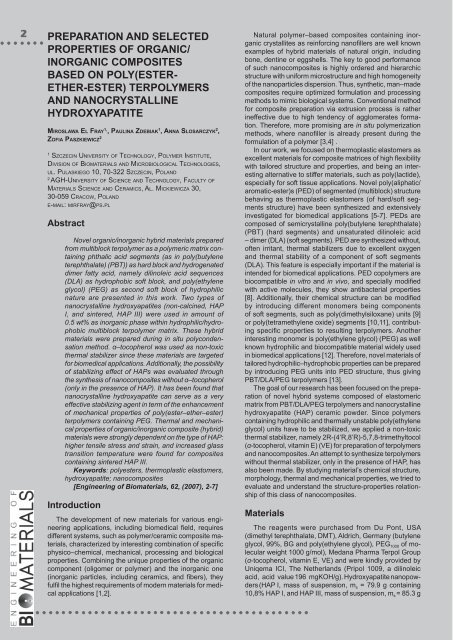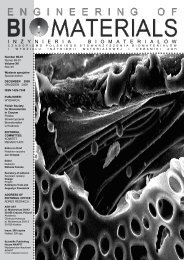62 - Polskie Stowarzyszenie BiomateriaÅów
62 - Polskie Stowarzyszenie BiomateriaÅów
62 - Polskie Stowarzyszenie BiomateriaÅów
Create successful ePaper yourself
Turn your PDF publications into a flip-book with our unique Google optimized e-Paper software.
2 PREPARATION AND SELECTED<br />
PROPERTIES OF ORGANIC/<br />
INORGANIC COMPOSITES<br />
BASED ON POLY(ESTER-<br />
ETHER-ESTER) TERPOLYMERS<br />
AND NANOCRYSTALLINE<br />
HYDROXYAPATITE<br />
MIROSLAWA EL FRAY 1, , PAULINA ZDEBIAK 1 , ANNA SLOSARCZYK 2 ,<br />
ZOFIA PASZKIEWICZ 2<br />
1<br />
SZCZECIN UNIVERSITY OF TECHNOLOGY, POLYMER INSTITUTE,<br />
DIVISION OF BIOMATERIALS AND MICROBIOLOGICAL TECHNOLOGIES,<br />
UL. PULASKIEGO 10, 70-322 SZCZECIN, POLAND<br />
2<br />
AGH-UNIVERSITY OF SCIENCE AND TECHNOLOGY, FACULTY OF<br />
MATERIALS SCIENCE AND CERAMICS, AL. MICKIEWICZA 30,<br />
30-059 CRACOW, POLAND<br />
E-MAIL: MIRFRAY@PS.PL<br />
Abstract<br />
Novel organic/inorganic hybrid materials prepared<br />
from multiblock terpolymer as a polymeric matrix containing<br />
phthalic acid segments (as in poly(butylene<br />
terephthalate) (PBT)) as hard block and hydrogenated<br />
dimer fatty acid, namely dilinoleic acid sequences<br />
(DLA) as hydrophobic soft block, and poly(ethylene<br />
glycol) (PEG) as second soft block of hydrophilic<br />
nature are presented in this work. Two types of<br />
nanocrystalline hydroxyapatites (non-calcined, HAP<br />
I, and sintered, HAP III) were used in amount of<br />
0.5 wt% as inorganic phase within hydrophilic/hydrophobic<br />
multiblock terpolymer matrix. These hybrid<br />
materials were prepared during in situ polycondensation<br />
method. α–tocopherol was used as non-toxic<br />
thermal stabilizer since these materials are targeted<br />
for biomedical applications. Additionally, the possibility<br />
of stabilizing effect of HAPs was evaluated through<br />
the synthesis of nanocomposites without α–tocopherol<br />
(only in the presence of HAP). It has been found that<br />
nanocrystalline hydroxyapatite can serve as a very<br />
effective stabilizing agent in term of the enhancement<br />
of mechanical properties of poly(ester–ether–ester)<br />
terpolymers containing PEG. Thermal and mechanical<br />
properties of organic/inorganic composite (hybrid)<br />
materials were strongly dependent on the type of HAP:<br />
higher tensile stress and strain, and increased glass<br />
transition temperature were found for composites<br />
containing sintered HAP III.<br />
Keywords: polyesters, thermoplastic elastomers,<br />
hydroxyapatite; nanocomposites<br />
[Engineering of Biomaterials, <strong>62</strong>, (2007), 2-7]<br />
Introduction<br />
The development of new materials for various engineering<br />
applications, including biomedical fi eld, requires<br />
different systems, such as polymer/ceramic composite materials,<br />
characterized by interesting combination of specific<br />
physico–chemical, mechanical, processing and biological<br />
properties. Combining the unique properties of the organic<br />
component (oligomer or polymer) and the inorganic one<br />
(inorganic particles, including ceramics, and fi bers), they<br />
fulfil the highest requirements of modern materials for medical<br />
applications [1,2].<br />
Natural polymer–based composites containing inorganic<br />
crystallites as reinforcing nanofillers are well known<br />
examples of hybrid materials of natural origin, including<br />
bone, dentine or eggshells. The key to good performance<br />
of such nanocomposites is highly ordered and hierarchic<br />
structure with uniform microstructure and high homogeneity<br />
of the nanoparticles dispersion. Thus, synthetic, man–made<br />
composites require optimized formulation and processing<br />
methods to mimic biological systems. Conventional method<br />
for composite preparation via extrusion process is rather<br />
ineffective due to high tendency of agglomerates formation.<br />
Therefore, more promising are in situ polymerization<br />
methods, where nanofi ller is already present during the<br />
formulation of a polymer [3,4] .<br />
In our work, we focused on thermoplastic elastomers as<br />
excellent materials for composite matrices of high flexibility<br />
with tailored structure and properties, and being an interesting<br />
alternative to stiffer materials, such as poly(lactide),<br />
especially for soft tissue applications. Novel poly(aliphatic/<br />
aromatic-ester)s (PED) of segmented (multiblock) structure<br />
behaving as thermoplastic elastomers (of hard/soft segments<br />
structure) have been synthesized and extensively<br />
investigated for biomedical applications [5-7]. PEDs are<br />
composed of semicrystalline poly(butylene terephthalate)<br />
(PBT) (hard segments) and unsaturated dilinoleic acid<br />
– dimer (DLA) (soft segments). PED are synthesized without,<br />
often irritant, thermal stabilizers due to excellent oxygen<br />
and thermal stability of a component of soft segments<br />
(DLA). This feature is especially important if the material is<br />
intended for biomedical applications. PED copolymers are<br />
biocompatible in vitro and in vivo, and specially modifi ed<br />
with active molecules, they show antibacterial properties<br />
[8]. Additionally, their chemical structure can be modifi ed<br />
by introducing different monomers being components<br />
of soft segments, such as poly(dimethylsiloxane) units [9]<br />
or poly(tetramethylene oxide) segments [10,11], contributing<br />
specifi c properties to resulting terpolymers. Another<br />
interesting monomer is poly(ethylene glycol) (PEG) as well<br />
known hydrophilic and biocompatible material widely used<br />
in biomedical applications [12]. Therefore, novel materials of<br />
tailored hydrophilic–hydrophobic properties can be prepared<br />
by introducing PEG units into PED structure, thus giving<br />
PBT/DLA/PEG terpolymers [13].<br />
The goal of our research has been focused on the preparation<br />
of novel hybrid systems composed of elastomeric<br />
matrix from PBT/DLA/PEG terpolymers and nanocrystalline<br />
hydroxyapatite (HAP) ceramic powder. Since polymers<br />
containing hydrophilic and thermally unstable poly(ethylene<br />
glycol) units have to be stabilized, we applied a non-toxic<br />
thermal stabilizer, namely 2R-(4’R,8’R)-5,7,8-trimethyltocol<br />
(α-tocopherol, vitamin E) (VE) for preparation of terpolymers<br />
and nanocomposites. An attempt to synthesize terpolymers<br />
without thermal stabilizer, only in the presence of HAP, has<br />
also been made. By studying material’s chemical structure,<br />
morphology, thermal and mechanical properties, we tried to<br />
evaluate and understand the structure-properties relationship<br />
of this class of nanocomposites.<br />
Materials<br />
The reagents were purchased from Du Pont, USA<br />
(dimethyl terephthalate, DMT), Aldrich, Germany (butylene<br />
glycol, 99%, BG and poly(ethylene glycol), PEG 1000 of molecular<br />
weight 1000 g/mol), Medana Pharma Terpol Group<br />
(α-tocopherol, vitamin E, VE) and were kindly provided by<br />
Uniqema ICI, The Netherlands (Pripol 1009, a dilinoleic<br />
acid, acid value 196 mgKOH/g). Hydroxyapatite nanopowders<br />
(HAP I, mass of suspension, m s = 79.9 g containing<br />
10,8% HAP I, and HAP III, mass of suspension, m s = 85.3 g













